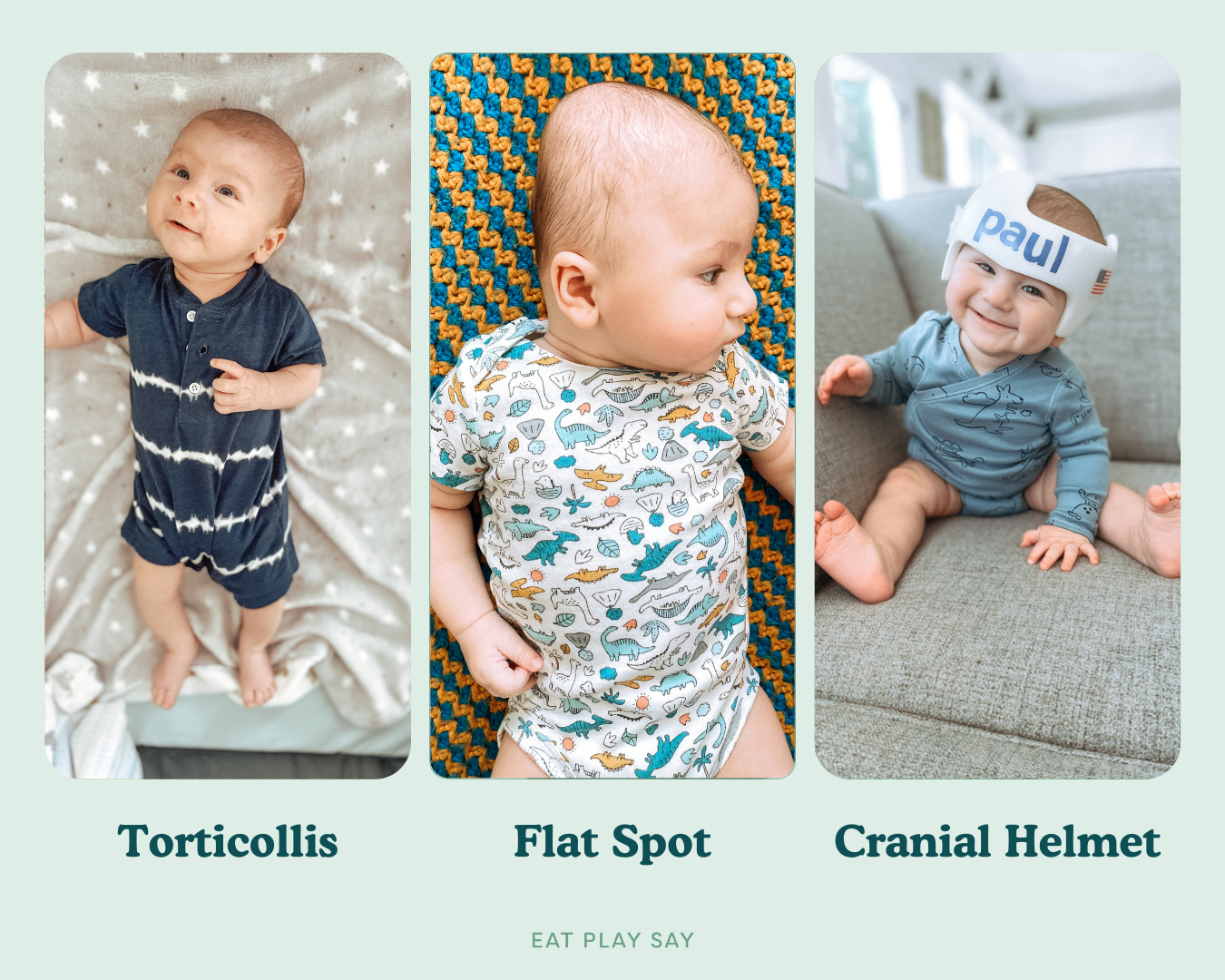This page contains affiliate links. We will receive a commission on qualifying purchases using these links.
The Physical Therapist on the team talks about one of the most common conditions in newborn babies.
Torticollis – or tight neck – is a condition primarily seen in newborns and young babies. Typically, one side of the neck is tighter than the other, causing a baby to have difficulty turning his or her head. It can also cause a head tilt to the side of the tightness.
Torticollis can cause plagiocephaly (flat spots on the head) and delayed motor milestones.
Signs of Torticollis in Babies
Have you noticed your baby prefers to look in the same direction when lying on their back or stomach or have more difficulty tracking a toy to one side? Does every picture of your baby show them looking the same way? Does your baby prefer to breastfeed on the same side or have difficulty accepting a bottle when holding them one way? These are all potential signs of torticollis. If you notice any of these, remember that early intervention is key to correcting torticollis!
Head Turning Preference in Babies
My son Paul had Torticollis and I missed it. But looking back through my camera roll, I can see the head turning preference so clearly! He also struggled to get into position to feed and didn’t enjoy being moved out of his “comfortable” position of his head turned to the right and nestled down near his shoulder.
Some babies are born with Torticollis due to positioning in the womb or during labor and delivery. Others develop Torticollis in the early months of life due to muscle tightness, positioning, or excessive use of equipment like swings, bouncer seats, and infant loungers. See our blog on Container Baby Syndrome here.
Early intervention (receiving physical/occupational therapy, stretching routines, modifying activities and positioning) may help correct Torticollis, prevent or help reverse head flattening, and, if help is received early enough, it can prevent the need for a helmet due to head flattening! If you want more information about head flattening, check out our blog here!
Signs of Body Tension or Muscle Tightness
If you notice any of the following, your baby may have Torticollis or body tension and an evaluation with a trained professional is recommended to confirm or rule out:
-
Your baby only rolls one direction
-
Feeding baby is difficult – poor latch, arching back, discomfort during and after feeding, reflux
-
Baby moves one arm or leg more freely than the other
-
Red neck creases are present, especially if more prominent on one side of the neck
-
Difficulty with tummy time
-
Baby seems uncomfortable in the car seat
How to Treat Torticollis and Body Tension
Early intervention is so important for little ones who have Torticollis or body tension because the sooner it is corrected, the sooner babies can catch up with their milestones! If you are worried, call your baby’s pediatrician to discuss your concerns. You can also self-refer to early intervention in the USA if you have a concern. Evaluations are free in all states and therapy is no-cost or low-cost if baby qualifies! Since it is so important to get early intervention, we don’t want to wait and see! It is better to “check and see” and be told there’s no concern than wait too long and miss the window for best results.
Activities for Torticollis at Home
Sometimes, evaluations take a while to get scheduled so even if you call right away, you may have to wait!
Here are some things to try while you wait:
-
Give your baby the most chances to look the other direction – rotate which end of the bed your baby faces when they sleep, switch their direction on the changing table, hold them alternating directions in your arms
-
Work on tracking toys in both directions when lying down – you want your baby to look both ways equally on their back and belly. Babies are most attracted to high contrast or brightly colored toys and your face!
-
Play with your baby in sidelying – a great way to work on bringing hands to midline and give your baby time off the back of their head. We have a blog all about sidelying here!
-
Practice tummy time in short spurts on the floor or on your chest. Use a baby carrier to get chores done around the house instead of a bouncer or swing. Limit container use to 15 minutes because bouncers and swings tend to limit head movement. Use a playpen or a blanket on the floor to lay your baby down instead. Check out our blog about containers here!
If Torticollis is Left Untreated
If Torticollis or body tension is left untreated, babies can develop flat spots on their head. Significant flattening of the skull may require helmet therapy. Helmets are most beneficial before a year of age, so it is best to get evaluated early if you notice that your baby has a flat spot or uneven eyes or ears. Head shape is important later in life for proper fit of bike/sports helmets, hats and glasses! To read about our helmet journey, check out this blog!
Another big concern is delayed motor milestones. Babies with Torticollis often prefer to roll one direction and can develop weakness on one side of their bodies. They may have difficulty with movements that require using both sides of their bodies together, like crawling and walking. They can have difficulty with sitting unsupported and reaching for toys while sitting. Eating difficulties may arise due to poor posture in sitting.
No matter what happens, remember that it is NOT your fault. Don’t be afraid to ask for help if you notice that your baby has tightness or a flat spot. Don’t be ashamed if your baby needs a helmet or physical therapy. Remember that you are just doing what is best for your baby!
If you want to talk to a professional about your little one, you can schedule a 1:1 consultation here!
If you are looking for a professional near you to treat Torticollis or body tension, look for a physical therapist, occupational therapist or cranial sacral therapist trained in young infants.
Being aware of milestones is a good thing. So, we put them all in one place, for FREE!
Grab our most downloaded Freebie so you can always “check and see.”








